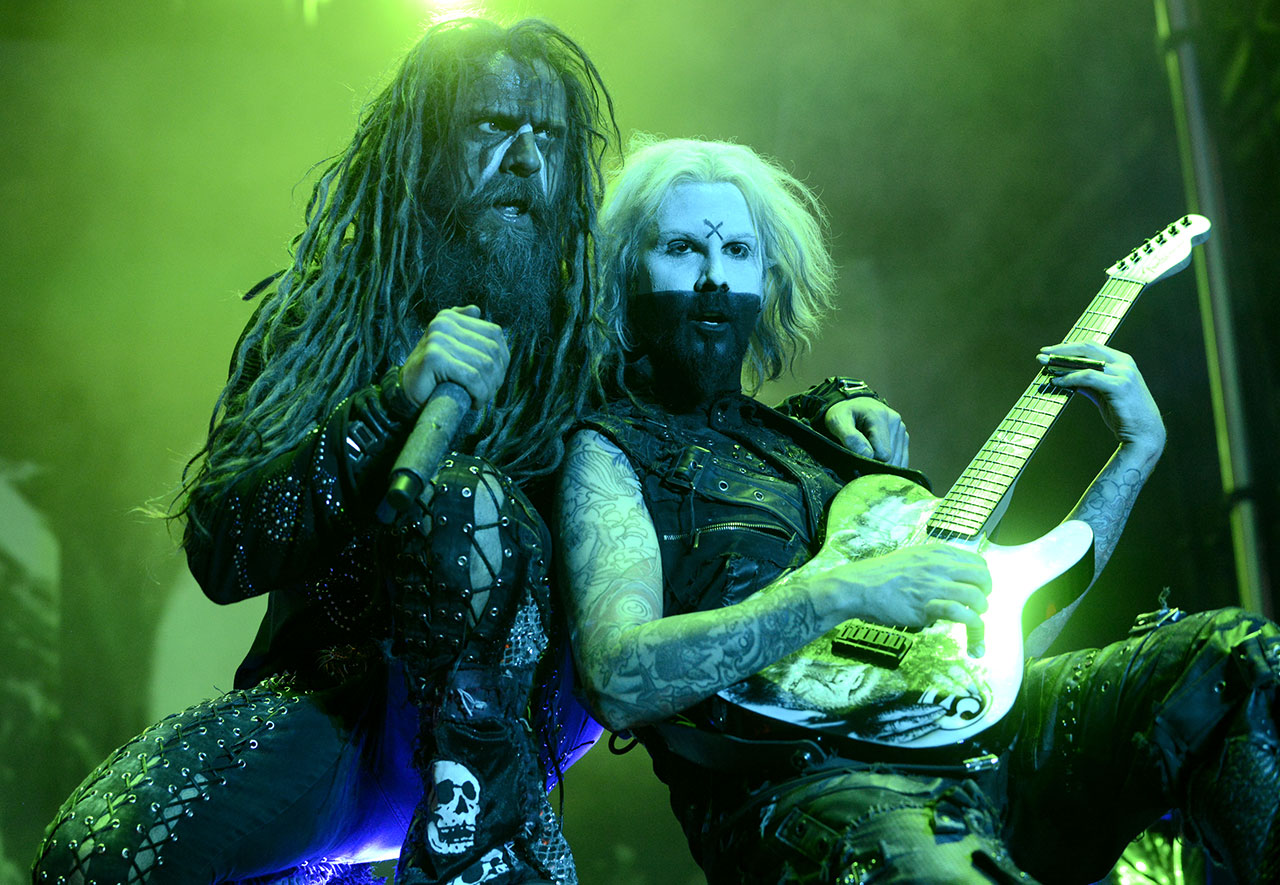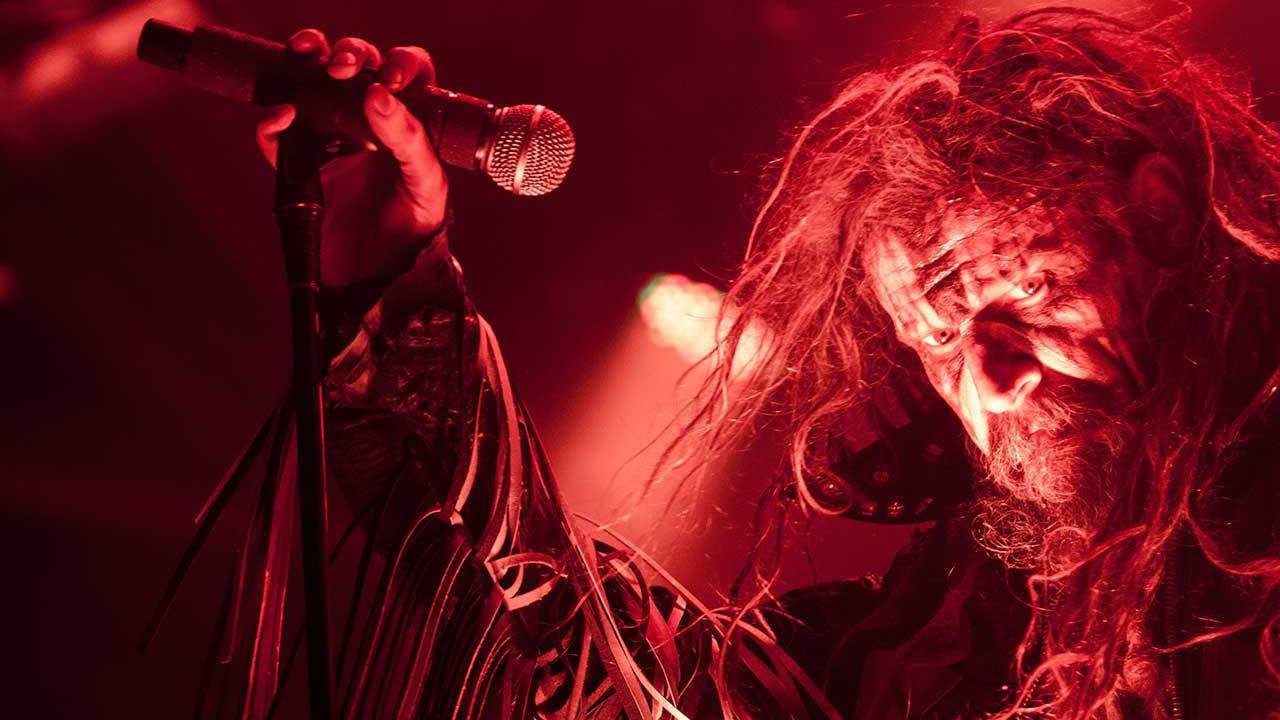Born Robert Cummings in 1965, the man now known as Rob Zombie is a household name for metalheads and horror buffs everywhere. From his early days with the groundbreaking industrial pioneers White Zombie, through to his monstrous solo career, and his subsequent foray into directing horror movies – there’s not a lot that Rob hasn’t seen or done, and at 54 years of age, he shows no signs of slowing down.
Here are 26 things you need to know about the tentacle-haired circus master.
A is for Alice Cooper
Although Screamin’ Jay Hawkins was rising out of coffins on stage as early as 1956, Alice Cooper is the undisputed godfather of shock rock and without him there would be no Rob Zombie. When the ghastly duo collaborated on Zombie’s first song as a solo artist, Hands Of Death (Burn Baby Burn) in 1996, Zombie described the experience as one of the “great moments where you really feel like you’ve made your dreams come true.” We’re not worthy, indeed.
B is for Beavis And Butt-Head
It seems implausible in today’s over-saturated internet-driven society, but during the mid-90s when alternative rock was at its peak Beavis And Butt-Head was the principal platform for discovering new bands. The channel-surfing lugheads were legitimate tastemakers – Zombie himself once referred to them as “the Siskel and Ebert of the retarded generation” – capable of breaking acts in America. Case in point: after the video for White Zombie’s Thunder Kiss 65 started airing on the show, the album it was lifted from (La Sexorcisto: Devil Music Volume One) climbed to number 37 in the Billboard chart. The band’s song Ratfinks, Suicide Tanks And Cannibal Girls was also used as the soundtrack to Beavis And Butt-Head Do America.
C is for CBGB
Way before White Zombie became alt-metal titans and heroes of the Beavis And Butt-Head-era, they were meagre art-school students struggling to make ends meet on the Lower East Side of Manhattan. And like many of their peers, they made their live debut at the illustrious New York music venue, CBGB. Tommy Victor from Prong was actually running the soundboard that night, so you’ll have to ask him what he thought of their first performance.
D is for Devil’s Rejects, The
Ever since the release of his directorial debut House of 1000 Corpses in 2003, Rob Zombie has grown just as famous for his movies as for his music. Corpses was an inventive riff on The Texas Chainsaw Massacre but its camp humour meant it lacked the fear factor of Tobe Hooper’s original cult shocker. For this 2005 sequel, however, Zombie eschewed his first film’s tongue-in-cheek approach for a considerably darker, more realistic tone. To this day it remains his masterwork, and if there’s ever been a better use of Lynyrd Skynyrd’s Freebird in the history of cinema then Baby’s dad ain’t Captain Spaulding.
E is for Educated Horses
Released in 2006, Educated Horses is the third solo album by Rob Zombie. It was also the first album to feature long-term collaborator John 5 on guitar and the last to feature bassist Blasko; who went on to replace Robert Trujillo in Ozzy Osbourne’s band after Trujillo joined Metallica. The songs pulled away from the industrial programming Zombie was predominantly known for at that point, and leant towards the larger-than-life glam rock of Slade and Meat Loaf. Hell, even glam metal pin-up Tommy Lee laid down some beats for the record, as did rock’s premier to-go drummer for hire, Josh Freese.
F is for Films
Forget about Rob Zombie’s filmmaking career for a second; cinema is the central thread throughout his music career as well. White Zombie were named after a 1932 horror film starring Béla Lugosi and the band sampled such ‘70s classics as Star Wars, Dawn Of The Dead and Shaft, while his solo output is littered with soundbites taken from obscure B-movies like Daughters Of Darkness, The Amazing Colossal Man and The Satanic Rites Of Dracula. The only guy who probably knows more about grindhouse cinema than Rob Zombie is king film geek Quentin Tarantino, but more on him later on.
G is for God Of Thunder
After Alice Cooper, the band that’s had the most influence on Zombie’s stagecraft is Kiss. White Zombie paid tribute to the men in the paint by releasing a cover version of God Of Thunder as a vinyl-only single back in 1989, and Zombie later sang lead vocals on the song alongside Ace Frehley, Slash, Tommy Lee, Gilby Clarke and Scott Ian during the VH1 Rock Honors of Kiss, Queen, Def Leppard and Judas Priest in 2006. Other performances that night included a Judas Priest medley by Godsmack and The All-American Rejects covering Def Leppard’s Photograph – but the less said about that the better.
H is for Hellbilly Deluxe
Hellbilly Deluxe is the debut solo album by Rob Zombie. Much to the singer’s surprise and delight, it out-sold all of White Zombie’s albums and remains his best-selling release to date, producing two hit singles – Dragula and Living Dead Girl – and establishing him as a successful artist in his own right. As the mainman himself pointed out, “There’s not a long track record of people having more successful solo careers after leaving bands, especially in the hard rock field. It’s pretty much only Ozzy.” Well, Zombie followed in the footsteps of The Prince Of Darkness and smashed it out the park.
I is for It Came From N.Y.C.
Depending on what format you buy it on, It Came From N.Y.C. is a five LP/three CD anthology of White Zombie, featuring previously unreleased or out of print tracks and a 108-page booklet that painstakingly chronicles the band’s emergence from the underground New York noise rock scene, alongside acts like Swans and Sonic Youth. In short, it’s an essential purchase for all the hardcore White Zombie fans out there.
J is for John 5
Born John William Lowery in 1971, but christened John 5 by the Antichrist Superstar in 1998, the virtuoso guitarist had already played with Marilyn Manson, David Lee Roth and Rob Halford before joining Rob Zombie’s band in 2005. And it’s easy to see why he’s so in demand: he’s a master of all styles, ranging from country to metal and everything in between, and he looks like a total badass on stage. He’s served as Zombie’s right hand man for over a decade and had a heavy hand in the sound of his last four albums.

K is for Kurt Cobain
What does the late Nirvana frontman have to do with Rob Zombie, we hear you ask? Well, back in the late ‘80s when White Zombie sounded more like The Birthday Party and Butthole Surfers than Ministry or Nine Inch Nails, Kurt Cobain cited the band as one of his biggest influences. Psycho-Head Blowout was allegedly one of his favourite EPs, while Soul-Crusher was one of his favourite albums, and he particularly admired the work of guitarist Tom ‘5’ Guay. So there you go.
L is for Lords Of Salem, The
After directing a remake of Halloween and a sequel to boot, Rob Zombie clearly craved something fresh and original, which led him to this Ken Russell-inspired reimagining of the Salem witch trials. As usual, the film stars his wife Sheri Moon Zombie in the central role (it’s probably her best performance to date) and his old pal John 5 composed the music. But unlike his previous grindhouse-friendly films, The Lords Of Salem has a much slower pace and a more impeding sense of dread, placing it in the realms of classic supernatural horror films like Rosemary’s Baby, The Shining and Suspiria as opposed to cult slashers like The Texas Chainsaw Massacre and Halloween, which he’d drawn inspiration from for his previous films.
M is for More Human Than Human
More Human Than Human is the highest charting, most recognisable single in White Zombie’s entire back catalogue. It was taken from the band’s fourth and final album Astro-Creep: 2000 and was inspired by the Phillip K. Dick novel Do Androids Dream Of Electric Sheep?, which was the source material for the film Blade Runner. But you probably knew that. What you might not know is that the clip of a woman having an almighty orgasm at the start of the song was sampled from the post-apocalyptic porn movie (yes, that’s an actual genre) Café Flesh. Something to think about.
- Rob Zombie: My Life Story
- 5 things we learned at Rob Zombie's headline London show
- 21 Years Of White Zombie – Astro-Creep: 2000
- The Rob Zombie Lyrics Quiz: can you match the line to the song?
N is for Number 31
Not only is 31 the date of Halloween, Zombie’s favourite in the calendar year; it’s also the title of his latest cinematic release. The film stars all the usual suspects – Sherri Moon Zombie, Jeff Daniel Phillips, Meg Foster and Malcolm McDowell – and takes place on his favourite day (Halloween, duh) during his favourite decade (the ‘70s) in his favourite territory (redneck country). It’s by no means his best effort, but it’s worth the entry price for Richard Brake’s performance as Doom-Head, delivering the kind of razor sharp dialogue that Tarantino would be proud of.
O is for Ozzy Osbourne
Zombie’s friendship with the double O dates back to 2001, when Ozzy sang vocals on Iron Head from Zombie’s second solo album, The Sinister Urge. Zombie repaid the favour the following year by directing the music video to Ozzy’s John Lennon-esque single Dreamer, but their relationship has not been without its dramas, and in 2010 Zombie publicly called Osbourne out for stealing his bandmates – by that point both bassist Blasko and drummer Tommy Clufetos had left Zombie to join Ozzy’s band. They quickly buried the hatchet though, and in 2013 Zombie fondly recalled the time he and Ozzy smoked crack with Rick James. As you do.
P is for Powerman 5000
It’s a well known fact that Boston-based industrial metal band Powerman 5000 are fronted by Rob’s younger brother, Michael David Cummings, aka Spider One. Their most notable hit to date is When Worlds Collide from the 1999 album Tonight The Stars Revolt!, which appeared on Tony Hawk’s Pro Skater 2 and the soundtrack to Little Nicky. The band gained further mainstream exposure in 2001 when they recorded a cover of Relax by Frankie Goes To Hollywood for the Zoolander soundtrack, and they’ve had music appear in various films, games and TV shows ever since. If it were any other family he’d be the golden boy, but when your brother’s Rob Zombie it’s gotta be tough.
Q is for Quentin Tarantino
In 2007, illustrious indie filmmaker Quentin Tarantino teamed up with his buddy Robert Rodriguez to write, produce and direct the double horror film feature presentation, Grindhouse. Tarantino’s segment was entitled Death Proof, while Rodriguez’s was called Planet Terror, and the two parts were bookended by fictional trailers for fictional films, directed by Eli Roth, Edgar Wright, and our man Rob Zombie. The story goes that Zombie approached Rodriguez at the Scream Awards and told him, “I have a trailer: Werewolf Women Of The SS.” Rodriguez’s response: “Say no more. Go shoot it. You got me.” For Zombie, the opportunity to work with Tarantino must’ve been another dream come true scenario.
R is for Remixes
Rob Zombie has always had a fondness for remixes. White Zombie released two remix albums (Nightcrawlers in 1992, which featured remixes by the German industrial band KMFDM, and their final album, the Terry Date-produced Supersexy Swingin’ Sounds, in 1996), and he’s put out two solo remix albums to date as well: American Made Music To Strip By and Mondo Sex Head, which includes tracks by Chino Moreno’s Crosses and Korn’s Jonathan Davis. The guy’s bloody remix mad!
S is for Sexorcisto: Devil Music Volume One, La
La Sexorcisto: Devil Music Volume One was White Zombie’s third album and it marked a major turning point in the band’s career. It was the first to feature newly-recruited guitarist Jay Yuenger, and it became a commercial and critical success thanks to the singles Thunder Kiss 65 and Black Sunshine, which both received heavy rotation on rock radio and MTV. Zombie’s appreciation of vintage trash culture also came to the forefront, thus showcasing the band’s unique identity and aesthetic.
T is for Thunder Kiss 65
Conceived as a tribute to sexploitation auteur Russ Meyer, Thunder Kiss 65 features samples from his camp magnum opus, Faster, Pussycat! Kill! Kill! (“You’re all shook up, aren’t you baby?” and “I never try anything; I just do. Wanna try me?”) and it went on to earn the band their first Grammy nomination for Best Metal Performance. Of course, credit must go to Beavis and Butt-Head creator Mike Judge for picking up the music video and playing it during the episode Yogurt’s Cool, thus introducing the band to a whole new generation of teens across the States.
U is for Ultraviolence
The term “ultraviolence” first appeared in the Anthony Burgess novel A Clockwork Orange, which Stanley Kubrick adapted into a film starring Malcolm McDowell in 1971. That film, and McDowell’s performance in particular, had a profound impact on Zombie, who later cast McDowell as Dr. Loomis in his remakes of Halloween I and II, and as the evil mastermind behind the game of death in his latest effort 31. Needless to say, Zombie is partial to a bit of the old ultraviolence himself, and if there’s one thing you can always bank on being in his films then it’s graphic amounts of blood and gore.
V is for Venomous Rat Regeneration Vendor
Two other things Zombie has a penchant for are ridiculously long album titles (see this year’s The Electric Warlock Acid Witch Satantic Orgy Celebration Dispenser) and covers of songs released in the ‘70s, both of which are present on his fifth solo album, Venomous Rat Regeneration Vendor, which includes a cover of Grand Funk Railroad’s We’re An American Band. The record came out just days after his fifth film The Lords Of Salem was released, and it was the first to feature drummer Ginger Fish, who, like John 5, used to be a member of Marilyn Manson’s band.
W is for White Zombie
What’s left to say about White Zombie at this stage in the game? Well, it’s worth pointing out that Rob Zombie would not be where he is today – both as a musician and a filmmaker – were it not for that band. It’s the group that put him on the map in the first place, and even though a White Zombie reunion still seems highly unlikely, you can always expect to hear the likes of Thunder Kiss 65 and More Human Than Human at any given Rob Zombie show. Why? Because they’re fucking great songs, and the band still stand up as one of the most thrilling and inventive acts of their era.
X is for X-Rated
Masturbation, murder, mutilation, necrophilia… Rob Zombie’s films have the lot, which makes it hard to gain them cinematic release, hence why financial backers are weary of working with the director, which is why he chose to crowd fund his last film. Nowadays, X-rated certification is called NC-17, and the struggle Zombie has with every film he makes is convincing the Motion Pictures Association of America to mark his films down from an NC-17 to an R rating so they can receive commercial distribution. The Devil’s Rejects, for instance, allegedly went through the MPAA eight times before it finally received an R rating. You have to admire that commitment to artistic integrity, and modern day cinema would be a far duller place without Rob Zombie.
Y is for Yseult, Sean
We’ve reached the penultimate entry in our list, so it seems fitting to take it back to the place where it all started for our protagonist; the day he met his ex-partner and co-founding member of White Zombie, Sean Yseult, in the cafeteria of Parsons School of Design in New York in 1985. Without her, and the initial bond and vision that she and Zombie shared, White Zombie might never have existed, and he might still be working as a TV set designer and calling himself Robert Cummings. Yseult’s role in the evolution of Rob Zombie cannot be overestimated, and if you want to read about the story from her perspective then her autobiography, I’m In The Band: Backstage Notes From The Chick In White Zombie, is well worth your time.
Z is for Zombie, Sheri Moon
Where else would we conclude our trip down Zombie lane than with the scream queen herself, Sheri Moon Zombie? She’s not only Zombie’s wife and life partner, she’s also his muse, appearing in all of his films, eleven of his solo music videos, and on the cover of three of his records (the Living Dead Girl and Demon Speeding singles and the American Made Music To Strip By remix album). As the old saying goes, behind every great man is a great woman, and it’s difficult to think of many others that have featured so prominently in their spouse’s body of work. Here’s to you, Sheri Moon Zombie. Don’t go changing.

